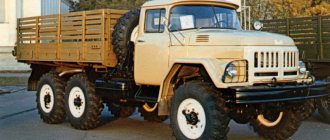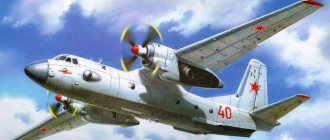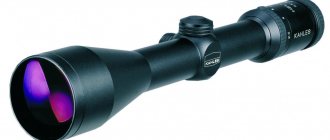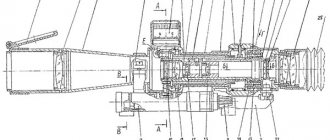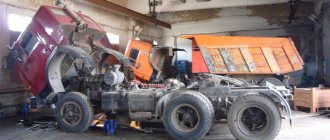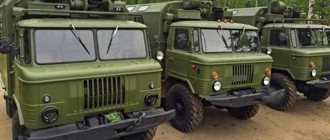Car engine
Despite the fact that the first production model of the car in question was released back in 1966, the technical characteristics of the engine in many areas satisfy the needs of the Russian army even today:
| Parameter name | Characteristic | Units |
| engine's type | Carburetor, four-stroke | |
| Number of working cylinders | 8 | PC. |
| Cooling type | Liquid | |
| Valves | At the top of the engine | |
| Diameter of working cylinders | 100 | mm |
| Working volume of the combustion chamber | 6 | l |
| Piston stroke length | 95 | mm |
| Compression | 6,5 | |
| Maximum engine power | 150 | l. With. |
| Torque at 2,000 rpm | 410 | N×m |
Thanks to its great power and high torque, the ZIL-131 could reach speeds of up to 85 km/h on the highway. Considering the year of manufacture, this parameter can be called quite impressive.
Not every passenger car of those years could move so fast, not to mention trucks of such a large mass.
The fuel consumption of the ZIL-131, shown in the photo on the right, with a mixed driving cycle is 49.5 liters per 100 km at an average speed of 60 km/h.
According to the technical specifications, the engine is designed to work with AI-76 gasoline or a similar one, but with a higher octane number.
Gasoline tanker
2. Worn valve stem seals. A classic sign of a malfunction is small puffs of bluish smoke coming out of the exhaust pipe when the engine cycles sharply increase. To resolve this problem, remove the engine valve cover. Remove the camshaft, then the rocker arms. Loosen and remove the valve springs, replace the caps. Reassemble everything firmly in the reverse order of disassembly. Be extremely careful when disassembling and reassembling so as not to drop the valve into the cylinder.
A little history of the car
The production of ZIL 131 began in 1967 and it was actively supplied to the market until 1994. Mass production was determined primarily by the purpose of the vehicle - to meet the needs of military forces in transporting military cargo. The development and transformation of basic plans into the final result was carried out by the Moscow Likhachev Plant. Their job was to create a high-quality replacement for the ZIL 157, but they failed to increase the average fuel consumption of the ZIL.
The ZIL-131 car appeared as a prototype in 1956. After passing all the necessary tests, the truck was included in the mass production plan. The start of serial production was scheduled for 1961, but due to some problems, production had to be postponed.
The first production batch rolled off the assembly line in 1967. However, the engineers did not waste time and managed to finalize their brainchild, and it became even better. The new truck, developed on the basis of the 130th, was supposed to replace the ZIL-157, which was obsolete by that time, in the Soviet Army. The new transport turned out better in everything: maneuverability, speed, comfort, carrying capacity.
KUNG and other modifications
The truck model in question turned out to be so successful that a large number of different modifications were produced on its basis.
ZIL-131 KUNG is especially popular. This abbreviation stands for “uniform body of zero overall size.”
Its frame is made of angles and channels of various sizes, sheathed on top with metal sheets.
Find out the technical characteristics of the Ural 375 engine in our article. And here we consider the Grunwald tipper, tilt and semi-trailer container carriers.
The inside of this ZIL-131 van body is lined with foam plastic or other heat-insulating material, after which everything is covered with antiseptic-coated plywood, which improves the technical characteristics of the entire vehicle.
Regardless of their purpose, all KUNG trucks in question are equipped with:
- heating;
- ventilation;
- all kinds of household equipment;
- lighting system (plafonds on the ceiling).
The uniqueness of the ZIL-131 KUNG was the presence in its body of a special filtration unit FVUA-100N-12.
It took air from the environment and disinfected it. Overpressure was created, which made it possible to protect the space inside the van.
The heating system was completely autonomous; heat was generated by burning diesel fuel.
Also, based on the truck in question, the following modifications with good technical characteristics were made:
- ZIL-131NA was equipped with leaky and unshielded equipment;
- ZIL-131V – truck tractor;
- ATZ-3 and similar ones were used as fuel tankers;
- MZ-131 – oil tankers;
- ATs-40 – fire engine.
Even after the production of this truck was officially stopped, it still continued to be produced with similar tactical and technical characteristics, but as AMUR-521320.
Weight, dimensions, load capacity
The weight and overall characteristics of the vehicle of this type are relatively small, despite its main purpose. The parameters are as follows:
- curb weight of the model without winch – 6,135 kg;
- curb weight of the model with winch is 6,375 kg.
Although, according to the technical specifications, the weight of the winch mechanism of the ZIL-131 vehicle is quite significant, its presence is always justified, since it allows you to cope with movement in extremely difficult and extreme terrain conditions.
Gross vehicle weight:
- with a winch - 10,425 kg;
- without winch - 10,185 kg.
The maximum load capacity is only 3,500 kg. Also, if necessary, the equipment in question can be used in conjunction with a trailer.
Its permissible weight depends on the road conditions in which the ZIL-131 travels:
- weight when driving on a paved road – 6,500 kg;
- when driving on a dirt road – 4,000 kg.
The basic version of the car has the following overall dimensions:
- length from the front bumper to the rear of the body, mm – 7,040;
- height without awning, mm – 2,480;
- height with awning, mm – 2,975;
- width from left wheel to right, mm – 2,500.
The ground clearance of the ZIL-131 is as much as 330 mm, which allows you to move without much difficulty even over rough terrain - in forests, fields or other similar places.
The distance between the wheels is 3.35 m +1.25 m. The width of the front and rear tracks is the same and is 1.82 m. The turning radius is as much as 10.8 m. Considering the length of the body, this parameter is not that great.
The braking distance is 29 m at 50 km/h. The reason for this is the large inertia arising from the mass of the entire car and van with people, as well as all the equipment available.
Equipment
Taking into account the high load capacity, the onboard ZIL-131 was equipped with a pair of static benches and one folding bench. The side sides are not folding, which did not affect the convenience of loading and unloading operations through the rear compartment. To ensure tension of the awning, special arches are provided. The configuration of the vehicle made it possible to mount other modular structures instead of a cargo body:
- field kitchen;
- base for missile launchers;
- fire equipment;
- boom with a cradle and the like.
Internal comfort was ensured through a number of innovations. Improved thermal insulation ensured ease of movement at sub-zero temperatures, and the voluminous windshield significantly improved visibility compared to its predecessor.
Chassis design
The chassis of the car in question includes the following main components:
- governance mechanisms;
- chassis;
- main power train (transmission).
ZIL-131 control mechanisms include:
- power steering with mechanical connection to the front wheels;
- braking system.
The chassis includes the following components:
- frame;
- axles on which the wheels are located;
- pendants.
The final drive of this truck is double, its gear ratio is 7.34.
Interesting Facts
During testing, the ZIL-131's carrying capacity, its performance and operational parameters improved significantly. One of the modernization factors was the transformation of the base chassis. As a result, the build quality and basic characteristics of the car have improved. The equipment was equipped with an improved motor, and the driver’s workplace received some ergonomic touches.
The innovations introduced at the time in the field of off-road trucks were welcomed and enthusiastically adopted. The modernization did not end there; in 1986, the vehicle was equipped with an updated engine, which made it possible to increase performance along with reducing the loss of operational resources.
Truck Features
Important! A special feature of this type of car is that the front axle is activated by an electro-pneumatic drive.
The organ that allows you to use it is located on the dashboard inside the cabin and is a regular metal two-position toggle switch.
Also, the front axle could be turned on using the gear shift lever.
The ZIL-131 gearbox is mechanical in its technical characteristics.
The second and third gears are equipped with special locks. They prevent the speed from being switched off inadvertently if the load on the engine increases rapidly. This is extremely important during a long climb.
For its year of production, the ZIL-131 is equipped with quite advanced electronics.
The design uses an alternator with a large power reserve, as well as contactless ignition with an electronic switching device.
In addition, there is a special vibration device that ensures movement for 30 hours without stopping on its own. All this was new for those years when the car in question began to be mass produced.
Cabin
The cabin on the ZIL-131 is of a frame type, the outside is sheathed with sheet metal, and the inside has various types of insulation. Its presence allows the driver to feel comfortable even in severe frost.
Ventilation of the interior is carried out by opening special vents in the doors, as well as side windows.
All moving elements are equipped with special rubber seals; their presence allows the closure to be as tight as possible.
The car's dashboard contains everything necessary to monitor the main engine parameters:
- gasoline level sensor;
- voltmeter/ammeter;
- speedometer;
- oil pressure sensor;
- temperature sensor;
- tachometer.
All controls necessary for comfortable operation of the car are within reach of the driver.
The turn control lever is located on the steering column. Everything else is on the dashboard to the right of the tachometer.
The control handles have the most suitable shape for grip, which allows you to perform various operations with maximum convenience.
The driver and passenger seats do not have many adjustments.
But, despite this, being in this cabin is quite pleasant: the designers made the seats taking into account the anthropometric parameters of the average person. Therefore, most drivers can drive the ZIL-131 with great comfort.
Do you know thanks to what technical characteristics the Ural 4320 machine creates maximum safety for the people in it? This review examines the advantages and disadvantages of the Amkodor 352 backhoe loader.
By following the link https://spez-tech.com/tehnika/selhoz/pritsepyi-i-polupritsepyi/gazel-avto/tyagach-s-funktsional-gruzovika-i-mobilnost-legkovogo.html, you will find information not only about possible prices for a GAZelle tractor with a semi-trailer, but also a description of the main types of this type of transport.
The cabin is equipped with impressively sized rear-view mirrors. Their viewing angle makes it possible to easily see everything that is behind the cab, even if the movement is carried out with a special trailer.

